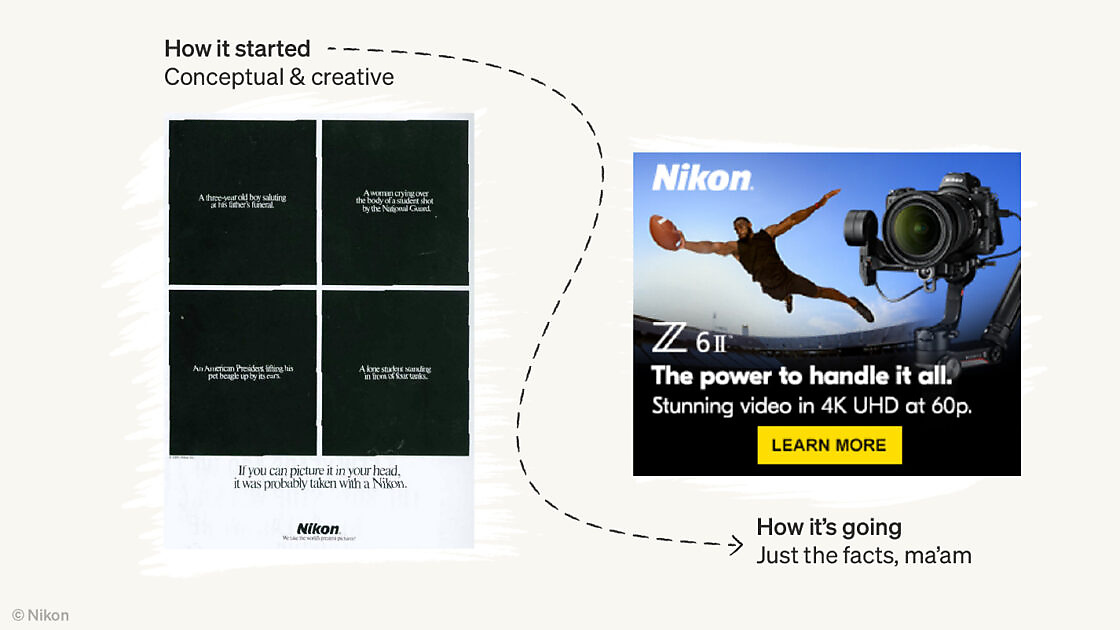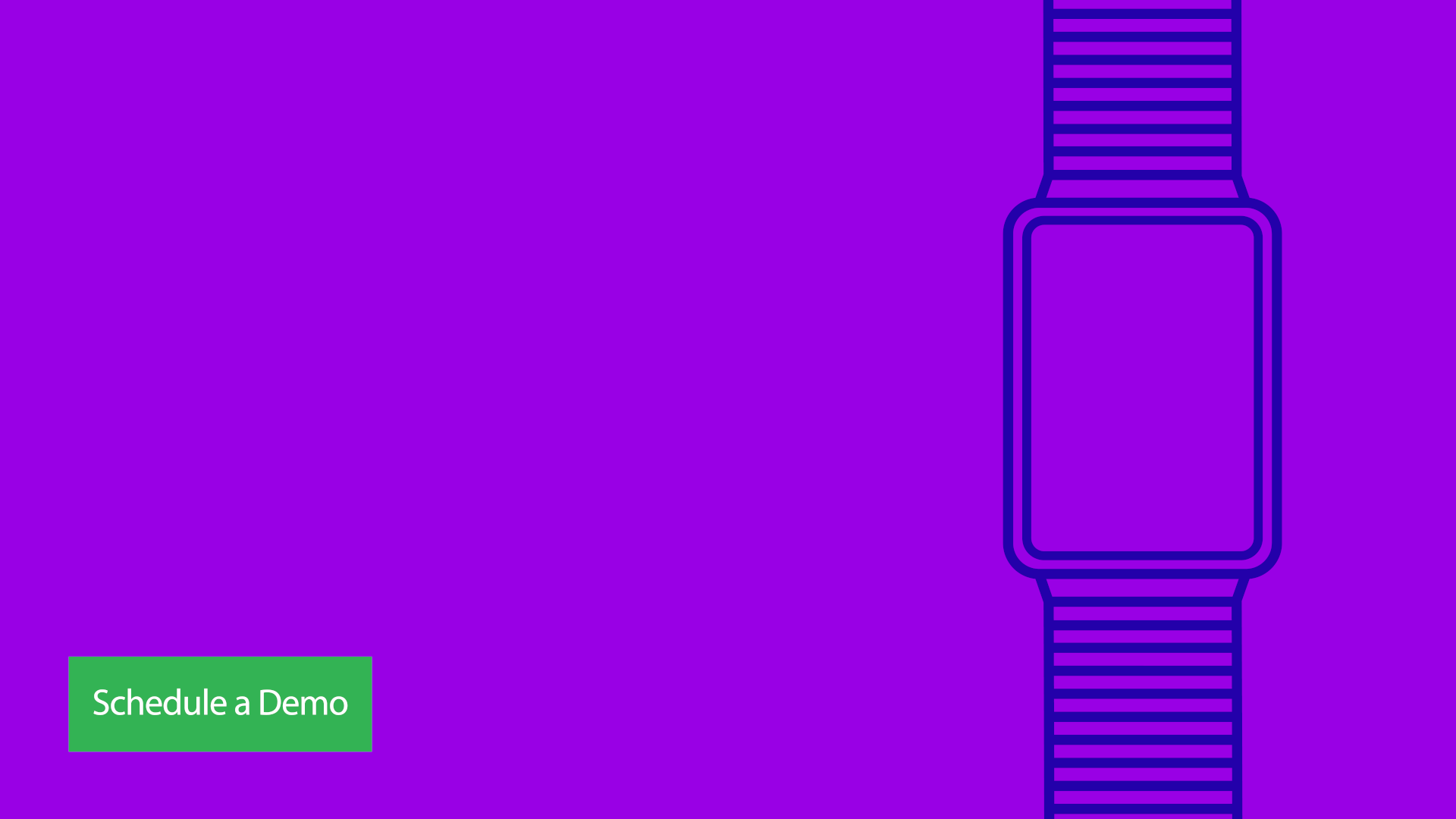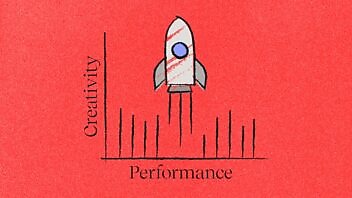Every now and then, someone posts a great Twitter thread like this comparing older, more conceptual ads against their newer, info-intensive counterparts.
And without fail, it reignites the debate over creative vs. performance marketing.

While creatives like to romanticize a time when imagination ruled supreme, most ads today anxiously get straight to the facts, ma’am.
Sometimes we see these needs as opposed:
- Clarity vs. cleverness
- Features vs. value
- Logic vs. art
- Metrics vs. mojo
But actually, the either/or framing is — to a large degree — bullshit. There is no vs. There’s only that old improv favorite: and.
Conceptually creative ads aren’t being coy. They’re applying artistry to proven psychological techniques. By not spelling everything out in black-and-white, these clever ads ask readers to fill in the blanks — and readers enjoy the challenge. They get invested. They think longer and more deeply than if you tell them ‘Hey buddy, here are three features.’
But today, ads need creative and strategy. The kind of stuff performance sharpshooters bring to the table: laser-focused targeting, keyword discipline, data-driven optimization.
Recently, we got to prove that strategy and art work better together — and create a big win for a client. They overcame a slump in their marketing by throwing out the dogma about performance vs. creative and trying something new.
Big reactions from creative-performance alchemy
Our client, a data startup, came to us with an interesting problem: they’d just had a major infusion of capital, and investors wanted to see fast results — in an insanely crowded and competitive market.
And the competition wasn’t their biggest problem. Our client was marketing to software engineers, a group notoriously skeptical for rolling their eyes before they even begin reading your ad. If they read your ad.
While we were auditing the client’s brand and existing content to create a performance blueprint, we took a fresh look at ads and started testing some new ideas.
We thought the ads should go a bit lighter on detail to make more room for playfulness, emotion and outcomes. That meant shedding depth while signaling technical credibility.
The campaign’s value prop was clean — basically ‘speed up your SQL queries’ — but the ads needed to point to an outcome that would overcome buyers’ natural inertia.
Rather than simply ‘speed up SQL,’ we decided to position the client’s product as a direct alternative to batch processing. (Sidebar for the non-data-geeks: batch processing means stacking a bunch of data jobs and then processing them all at once. It’s the normal way to process queries within large data sets but it typically means waiting a day or more).
So the copywriter had a few needles to thread:
- Grab the (bored, skeptical) audience’s attention
- Shift from details to outcomes …
- … while still signaling technical credibility
- And do it in roughly five words of copy (lol)
Our client understood that they needed to push the envelope to stand out so our lucky team got to try the playful, conceptual route.

Taking a chance — and applying creative thinking and craft to campaign logic — paid off. The results:
- 647 campaign leads — up 45% over the previous six months
- 73 opportunities — 3X more than the previous 6 months
- 17 deals converted, nearly 3X their benchmark
And everyone lived happily ever after.
For about six months. Because while the initial results were great, ads get tired if they run long enough (like us, not much farther than a kilometer). Our campaign strategist advised that a constrained target audience will see your ads multiple times if you run them too long, and the ads will often stop performing after six months or so.
So our copywriter Garry decided to do something different: write ads that made readers do some of the work — but also made them more tangible. He invented real-life scenarios where slow batch processing would cause frustration. And he worked with a designer to animate them.
See the results:


These ads work on a couple of levels. First, they make you fill in the gap instead of telling you why it’s bad your pizza notification is hours late, and why it happened. Second: they’re funny without trying too hard. Third — and this is often a hard sell — they trust their readers. The ads don’t spell out the benefits but show them. And instead of avoiding using specific situations because they don’t apply to every industry, the ads let readers extrapolate how the benefit would apply to their problems.
And, to turn a cranky and not-true expression on its head: no one ever went broke overestimating their readers’ intelligence. Audiences are in a rush, but spoon-feeding them a list of safe, generic benefits isn’t going to catch their eyes. When you can do something a bit daring and evocative, you have a real chance to break the scrolling momentum and get them thinking.
How many generic lists-of-three can say that?
How it started vs. how it’s going
Once upon a less metric-y time, advertisers relied on gut and creativity. We like to bemoan those halcyon days of yore when people used words like ‘halcyon’ and ‘yore,’ while performance marketers roll their sensible eyes — but creative skill and craft and concept are still needed. It’s just that we need to serve them up with a big dose of accountability, and an eye for testing.
Sometimes it even means we get to make bolder, more conceptually risky bets. Tell nervous stakeholders, ‘Let’s test and see if it works.’
The best teams these days have it all: great instincts, guts, big-time craftsmanship, and deeeeeep knowledge of channels and best practices.

Enjoyed this article?
Take part in the discussion








Comments
There are no comments yet for this post. Why not be the first?